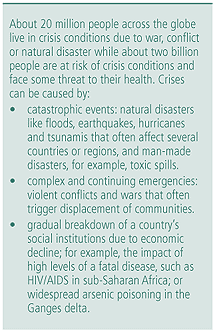WHO NEWS
Tsunami body count is not a ghoulish numbers game
Fiona Fleck
Geneva
Counting bodies in a major disaster is important to gauge the impact and humanitarian response needed from governments and donors. The difficulty of obtaining reliable figures in the Asian tsunami crisis has underscored WHO's recent work on geographic mapping of health facilities, particularly in developing countries.
The massive earthquake off the coast of Indonesia and resulting tsunami waves that wrought havoc along the rim of the Indian Ocean did not produce the biggest death toll from a single disaster but mark perhaps the steepest death count rise in history.
No other disaster has drawn so much attention to the need for reliable information on deaths, disease and destruction as the tsunami of 26 December 2004.
"We started with an estimate of 10 000 dead on the morning of 27 December, that grew to 153 000 within 10 days," said Dr Alessandro Loretti from WHO's Health Action in Crises department, who has been monitoring the crisis from Geneva since 26 December.
In the aftermath of the disaster, WHO has been an important source of information on its scale and impact.

Experts such as Dr Ties Boerma, Director of WHO's Measurement and Health Information Systems, say counting bodies is vital not out of ghoulish fascination but as a way for governments and donors to gauge the size of a disaster and tailor an appropriate humanitarian response.
Loretti, who has been working round the clock to keep the information flowing, said the tsunami death count has been even more difficult to estimate than that of other disasters. Political tensions and armed violence in Sri Lanka and Indonesia's Aceh province have not made this task easier, he said
Many bodies have not yet been discovered and may never be: some were washed out to sea, some were covered by debris and some were buried under sand churned up by the waves. The presence of tourists, migrant workers and other visitors in disaster-hit regions also made it difficult to provide reliable figures on the dead, missing and wounded.
Loretti told the Bulletin the task was most difficult in Indonesia's Aceh province, where the combined impact of earthquake and waves had devastating consequences. "In the immediate aftermath of the event, there was hardly anyone left or able to count and identify the dead, and inform their next of kin," Loretti said.
While the death toll reached more than 150 000 by mid-January, reliable figures on disease are now more urgently needed to prepare governments and humanitarian agencies to prevent outbreaks.
Loretti said disease surveillance and early warning of epidemics was a priority but also a major challenge due to missing health workers and damaged or destroyed infrastructure.
"It's a very fragile system of health posts and helpers who may have been washed away, of roads that have been washed away, telephone lines cut off and traumatized staff who have lost their relatives, friends and colleagues," Loretti said.
Loretti said WHO had helped to establish a skeleton early warning system using cellphones for disease surveillance in Indonesia's Aceh province and that so far there had been no major outbreaks.
The tsunami disaster has underscored the importance of having sound pre-existing health and population information to prevent outbreaks of disease and food shortages, and to help disaster-hit regions get back on the road to recovery, Boerma said.
Mapping or compiling detailed geographic information about the population, health facilities and services and other key public health information is essential for this, he said.
A global effort is under way with the help of WHO's Health Mapper software to build these geographic information systems.
Sri Lanka is a good example of a country where post-tsunami reconstruction efforts are now benefiting from such information, Boerma said.
Furthermore, he said that if vital registration systems are also in place, it is much easier to count the dead, missing and displaced, and plan the response after disaster strikes. The Health Metrics Network is an initiative by WHO and its international partners to help countries establish such reliable information systems.
Sri Lanka and the Maldives, which were also badly hit by the tsunami, have vital registration systems but reporting of births, deaths and causes of death is incomplete and delayed. Indonesia has no registration system at all, Boerma said.
"Most developing countries don't have good vital registration systems: you're not counted when you are born and you're not counted when you die," Boerma told the Bulletin. 

